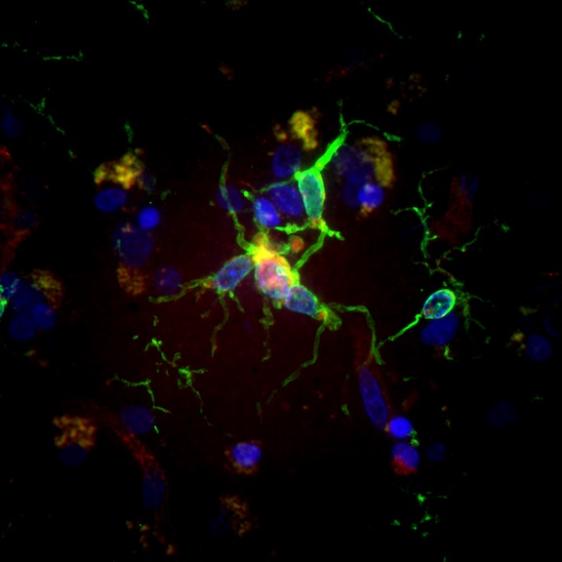
Image courtesy of Alexandra Cochoit, UW Neurology. This image from under a microscope shows several microglia cells (green) from the brain of a person who had Alzheimer’s disease during life. (More description below)
UW researchers using brain autopsy samples from 22 ADRC research participants have made a new discovery about human microglia and their relevance to Alzheimer's disease and targeted therapeutics.
Microglia are a type of cell that play very important roles in our brain health. They have a diversity of jobs, including maintaining normal brain function, fighting infections, and cleaning up and disposing of dead cells and waste. This waste-disposal system has the big responsibility of digesting clumps of abnormal proteins that can accumulate in the brain and eventually raise the risk of Alzheimer's disease.
Research suggests that in people with Alzheimer’s disease pathology in their brains, some microglia react too strongly, causing so much inflammation that the response drives the disease, rather than preventing it.
Unfortunately, the anti-inflammatory medicines tested so far have not been effective. "There's a hypothesis in the Alzheimer's field that if we could target specific groups of microglia that are contributing to this inflammatory environment, then maybe we could do better therapeutically," says Katherine Prater, PhD, a post-doctoral research fellow at the UW School of Medicine in the Jayadev Lab, who is first author on a new microglia study published in the July 2023 issue of Nature Aging.
The ADRC research team wanted to learn more about the groups of microglia that respond to Alzheimer’s disease. To do so, they studied the microglia gene expression, or the messages that get turned into proteins for use in the cell to perform in their specific job.
In the new paper, ADRC researchers describe three different groups of microglia that have not been seen before in the human brain. "That was pretty exciting for us to see," says Prater. All three groups showed signs of being involved in the waste disposal duties. But they found one of these groups more often in brains of people who had Alzheimer's disease during life. The gene expression of these microglia also showed signs of inflammatory activity. "This finding suggests that they might be responding to the stress of Alzheimer's pathology in a specific way," says Prater.
For the study, the team developed a new application of an existing technology to extract microglia from autopsied brain tissue. Their method allowed them to extract microglia in greater amounts than previously possible, giving them the ability to describe, in depth, the different groups of microglia cells that are present in the brain.
"One of the things I find cool about our data set, from a scientific perspective,” says Prater, “is that our findings in the human brain seem to fall right in line with the predictions made from research in animal and in vitro cell models [cells in a Petri dish] of Alzheimer’s disease."
The team also looked at a population of microglia well known to be involved in maintaining normal brain function, rather than cleaning up waste. When the ADRC team studied these cells, they found a subgroup of microglia that were only found in Alzheimer's disease brain tissue. These microglia showed evidence of sending messages between cells, giving the team another clue to how some microglia react to Alzheimer's disease and could potentially be targeted by a future treatment.
“Instead of using medications to treat the whole immune cell population, we can now target just the type of microglia that are harmful,” says Prater.
The team is now positioned to study microglia’s role in Alzheimer’s disease, with more precision than ever before. – Genevieve Wanucha
_
Study: Prater, K.E., Green, K.J., Mamde, S. et al. Human microglia show unique transcriptional changes in Alzheimer’s disease. Nat Aging (2023). This study was made possible in part by funding from NIA grant AG066509
Image: This image from under a microscope shows several microglia cells (green) from the brain of a person who had Alzheimer’s disease during life. Inside the middle cell, you can see some enlarged lysosomes (pink), which are a sign of the microglia reacting to the presence of Alzheimer’s disease proteins. Image courtesy of Alexandra Cochoit.




